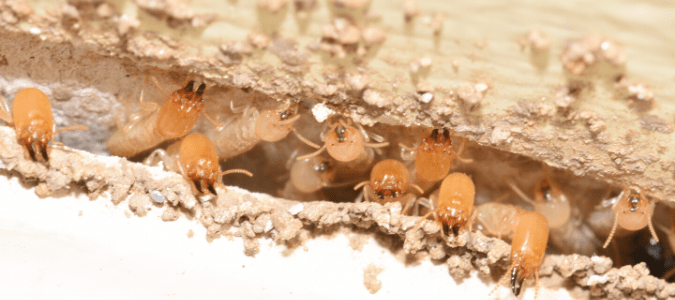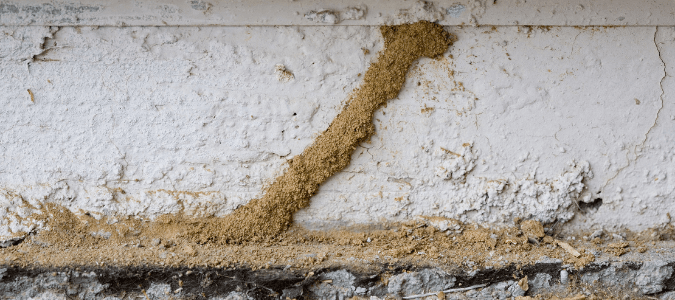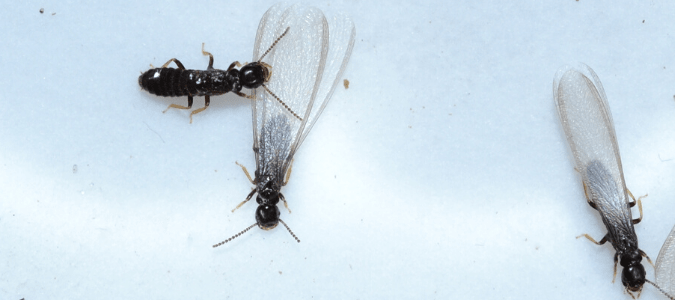How Do Termites Eat Wood?

What Do Termites Eat?
Termites don’t actually consume every part of the wood. They also don’t eat it just for the sake of nutrition. What they consume is actually the cellulose within the wood—the plant fiber that gives the wood its structure. Termites eat it for food. They also use it in building their nests as well as the tunnels connecting their nest with their main food and water sources.
An active termite colony can go undetected for a long time. This is partly because almost all the activity happens in darkness, hidden just underground or within the wood framing of a building, fence or deck. Since termites don’t make a noise like many other pests, they can cause damage quietly for a long time. Termites mostly avoid bright light, except during swarming season. Other than that, they live out almost their entire lives in the dark, hidden deep within a house or other structure.
As they consume the wood from the inside out, they build tunnels and larger open areas within the wood. These spaces are for moving from one place to another. They’re also for storing eggs and other purposes. Over time, these open areas start to weaken the wooden structure. Termites can cause so much damage in time that the wood starts to crumble away.
Signs of Termite Damage
The destruction caused by a termite infestation can be very expensive to fix, depending on how bad the damage is. But it needs to be fixed as soon as possible to make the structure safe and sound once again.
When termites infest a home, they’ll consume the home’s wooden framing and any other wood they can find. This might include baseboards or floorboards, or even wooden furniture. There may even be signs of termites in your yard, such as in your wooden decking or fencing that is attached to the house.
Though termites are best known for destroying wood, that’s not the only thing they can chew through. Termites have very powerful jaw parts they can use to chew through anything softer than wood. They can chew through drywall, insulation and carpet. These pests will work their way through any of these in order to get to the wood they need for survival.
If you think you might have a termite problem, it’s time to reach out to a professional pest control company for help. When your home is at risk of structural damage, it’s best not to mess around with do-it-yourself treatments that aren’t likely to work. It’s hard for non-professionals to know the scope of a termite colony and the damage it has caused. You might not even know where to look for the colony, or what signs to look for that might indicate an infestation.
Pest control professionals have the right training and experience for treating termite infestations. They have special instruments and techniques they use to find where these pests are nesting. Professionals know the signs that indicate an infestation and can customize a treatment plan for your home.

Identifying Termite Mud Tubes
If you spot hollow tubes made of dried mud on the outside of your home, these might be subterranean termite mud tubes. These tubes are several inches long and usually about the width of a pencil, but they may be up to a half-inch in diameter. Termites often build these tubes against the foundation of a home. They use them to travel back and forth unseen between their colony and their main food and water sources.
Other places where you might spot these mud tubes include inside a crawlspace, a crack in the foundation or in some other protected spot like inside of a wall. Termites make these tubes from a mixture of mud, chewed-up wood cellulose and sticky mouth secretions. Wherever you find them, the presence of mud tubes is a sure sign of pest activity. The question is, how recently have the tubes been used?
How to Tell if the Tubes Are Old or New
If the tubes are old, it’s possible they are from a previous termite infestation that was treated. But if they’re newer, however, it likely means there are termites currently active on your property. If that’s the case, the termites need to be treated by a pest control professional as soon as possible, to prevent further damage from happening to your home.
So how can you figure out whether mud tubes are new or old? One of the simplest ways to figure this out is to break off a little bit of the mud that makes up the tube. Wait a few days, and then go back to take a look at the spot where you broke part of the tube away. If it has been repaired, that means there are still active termites using the tube.
Of course, the best way to know whether there are active termites in or near your home is to have a professional termite inspection done. A pro knows where to look for termites and what signs to look out for. If they find that the mud tubes are being used by active termites, they can treat the pests. They can also recommend a follow-up inspection and treatment plan to ensure the problem doesn’t get worse again in the future.
Other Signs of an Active Infestation
There are several other signs of an active termite infestation to look out for:
- Narrow mud tubes, often found on exterior concrete walls or on the foundation of a home, near the ground. Subterranean termites build these so they can find food and water.
- Tiny holes in wooden furniture, baseboards, decking, wood flooring or other parts of your home that are made of wood. Termites consume wood from the inside out, so you may never see them, but you might see the tiny holes left behind by their tunneling.
- Frass—drywood termite droppings. These look like tiny pellets made of wood or sawdust. Piles of frass look a lot like piles of sawdust.
- Winged termites, also called swarmers. Adult termites might grow into workers, soldiers or swarmers. The swarmers are the only ones with wings. They are the termites that fly out from their colonies in spring, usually after the first big rain, to find a mate and establish a new colony together.
- Shed wings. When winged reproductive termites swarm out of their colonies in spring, they shed their wings after they find a mate. You might spot the discarded wings on a windowsill or a light fixture, near a door or near some other type of light source.
Any of these signs could indicate that you have an active termite infestation somewhere around your home. A pest control specialist can conduct an inspection to determine the extent of the infestation and figure out the right treatment plan.

Finding Winged Termites in the House
If you see winged termites in the house, you may not know what to do. You may not even know what they are, since they look a lot like winged ants. But it’s important to know exactly what type of pest you’ve spotted, so you can figure out how to eliminate them.
There are several ways to tell ants and termites apart. Take a look at the shape of their bodies, wings and antennae. Ants have a much narrower “waist” than termites do, and their antennae are bent like elbows. Termites’ bodies are more straight from top to bottom, and they also have straight antennae. Their two pairs of wings are the same length as each other, whereas ants have one pair of wings that is longer than the other.
If it’s springtime and getting warmer outside, and especially if it has rained recently, seeing winged termites in your house is a sign of an active termite colony nearby. Unfortunately, it’s also a sign that there may be new colonies forming soon if you don’t have the infestation treated.
Winged termites are the “reproductives”—the termites that fly out of the nest in spring, find mates and establish new colonies. You may not see the swarmers themselves, but they might leave behind signs of their swarming activity.
When winged termites find mates, they shed their wings before heading off to form a new colony together. You might see the shed wings near a window or exterior doorway. Spotting them could be an indicator that termites swarmed while you were away.
If you see termites swarming or find their shed wings, it’s time to contact a professional to treat the infestation before it gets worse.
Chem-Free Can Handle Your Termite Problems
Due to the potential damage termites can bring upon your home the best route to take is to contact a reliable pest control specialist. The professionals at Chem-free will be able to locate the termite colony residing in or near your home. They will create a termite treatment plan for your property. Our method of termite control is low-impact and effective for nine years after application, so you can feel comfortable knowing that your biggest investment is protected.
Need Help Managing Pests?
Chem-Free offers both effective, low-impact pest control options and preventative measures to help avoid future infestations. Contact us today for a free estimate!


